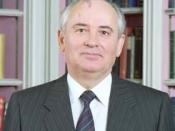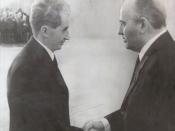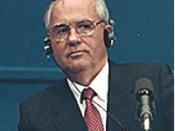After the Russo-Japnese war of 1905, in which Russia had lost, a revolution occurred. This being the second after an unsuccessful one in 1825. It appeared that discontent with the public would cause Czar Nicholas II to form a constitutional monarchy.
change such as this one would not have satisfied either the czar or his opponents. While the public wanted democratic freedom the czar did not want to lose control of the peasants. This one would also be unsuccessful.
Two more revolutions soon would occur and be successful. The first revolution occurred during World War I while the Russian military was pressed by war with Germany. The March Revolution of 1917 led to the abdication of Nicholas and the installment of
provisional government. The leader of this new government was Alexander Kerensky, who was eventually forced from power and later fled to America.
The armies that were at war were taken command by Czar Nicholas in the fall of 1915, leaving a power vacuum in the capitol city of St.
Petersburg. Suddenly in March of 1917 the collapse of the government came. Mass demonstrations were spawned by food
ots, strikes and war protests. The army refused to fire upon demonstrators. On March 14, a Soviet of Workers' and Soldiers' Deputies was elected, and it formed the provisional government which later caused the removal of Nicholas.
The leading men in the October 1917 revolution were Lenin and Leon Trotsky. Years later, on Joseph Stalin's orders, Trotsky was assassinated. No one could take action against the Bolsheviks who were subverting the army, passing out fire-arms, and appo
ting their supporters as commissars of military units. On the night of November 6-7 the Bolsheviks attacked, and gained control of the capitol after several days of fighting.
Meanwhile, Lenin had to deal with the...


